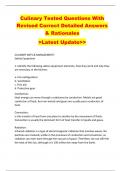Culinary Tested Questions With
Revised Correct Detailed Answers
& Rationales
>Latest Update>>
CULINARY ARTS & MANAGEMENT:
Safety Equipment
1. Identify the following safety equipment elements, how they work and why they
are necessary in the kitchen:
a. Fire extinguishers
b. Ventilation
c. First aid
d. Protective gear.
Conduction:
Heat energy can move through a substance by conduction. Metals are good
conductors of heat, but non-metals and gases are usually poor conductors of
heat.
Convection:
is the transfer of heat from one place to another by the movement of fluids.
Convection is usually the dominant form of heat transfer in liquids and gases.
Radiation:
Infrared radiation is a type of electromagnetic radiation that involves waves. No
particles are involved, unlike in the processes of conduction and convection, so
radiation can even work through the vacuum of space. Therefore, we can still feel
the heat of the Sun, although it is 150 million km away from the Earth.
,PRINCIPLES OF COOKING: (Part I)
Heat Transfer
1. Describe the following principles of heat transfer:
a. Conduction
b. Convection
c. Radiation.
Coagulation - the point at which proteins denature irreversibly and coagulate.
Gelatinization - Occurs when starch or flour granules swell when they come in
contact with a liquid. The swelling process causes the granules to thicken the
liquid in which they are immersed.
Caramelization - the removal of water via heat and the browning of sugar.
Oxidation process
Browning - Maillard, amino acids, reducing sugars and heat.
PRINCIPLES OF COOKING: (Part I)
Effects of Heat
1. Explain the following effects of heat:
a. Coagulation
b. Gelatinization
c. Caramelisation
d. Browning.
Baking
Heat transmitted by the convection and conduction of hot air to cook foods inside
an oven or other heatproof cooker.
Roasting
Like baking, roasting uses hot air as the heating medium in an oven or above an
open flame, as in rotisserie cooking, wood fired cooking and spit-roasting.
Transfer via convection and conduction.
,Grilling
Cooking method using hardwood, charcoal or open flame. Important to note that
the source of heat is generally from underneath.
Broiling:
Similar to grilling only the heat source is provided from above and wood is never
used. Modern broilers are designed to use both convection and radiant heat and
are typically gas fired or electric
BBQ
Cooking foods in an enclosed chamber at a relatively low temperature for an
extended period, usually in conjunction with smoking. Can be considered as a
combination method due to moist and dry heat.
PRINCIPLES OF COOKING: (Part I)
Dry Heat Cooking
broiling, grilling, roasting, sautéing, stir-frying, pan frying, deep frying
1. Describe each dry heat cooking procedure.
Broiling
dry-heat cooking method; cooking food directly under heat source with an oven;
steak, hamburgers, corn, vegetables
Grilling
dry-heat cooking method; cooking food directly over heat source; corn, steak,
hamburger, vegetables
Roasting
dry-heat cooking method; cooking large or whole pieces of meat or poultry in a
shallow pan; turkey, chicken, ham
PRINCIPLES OF COOKING: (Part I)
Dry Heat Cooking
broiling, grilling, roasting, sautéing, stir-frying, pan frying, deep frying
, 2. Recognise the related terminology and explain when each technique would be
used.
Sauteing
cooking with fat; means jumping around; cooking thinly sliced vegetables in a
small amount of fat over low to medium heat; thinly sliced carrots
Stir Frying
cooking with fat; cooking and stirring small pieces of food quickly at high heat in
very little fat in a wok; healthiest way to cook; beef, chicken, fish, vegetables,
carrots, snap peas, cauliflower
Pan Frying
cooking with fat; cooking tender cuts of meat, fish, or eggs in a small amount of
fat in a skillet; scrambled eggs, French toast, taco meat, bacon
Deep Frying
cooking with fat; food is cooked while completely covered in fat; least healthy
way to cook; French fries, onion rings
PRINCIPLES OF COOKING: (Part I)
Hot OIl Cooking
sautéing, stir-frying, pan frying, deep frying
2. Recognise the related terminology and explain when each technique would be
used.
Broiling - Grill heat from above
Grilling - Grill heat from below
Roasting - Oven, Rotisserie, Spit
Sauteing - Shallow Pan
Stir-Frying - Wok
Pan Frying - Shallow Pan
Deep Frying - Deep Pan, Deep Fat Fryer
PRINCIPLES OF COOKING: (Part I)
Hot Oil Cooking




